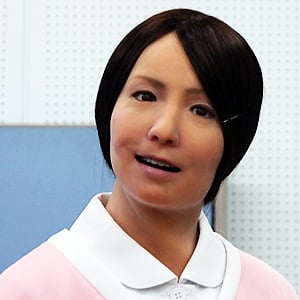
Japan's National Institute of Advanced Industrial Science and Technology and robot design company Kokoro have created male and female robot nurses in a bid to address patient needs in hospitals where there is a shortage of nurses.
While Actroid F, the female nurse was created some time ago, the companies built her male partner more recently and gave both 'retinas' to increase their functionality.
The robots imitate movements of the people they are watching and are placed as observers in hospitals to see how patients feel in their presence.
By placing cameras in the retinas of the robots they have made it possible for them to direct their line of sight towards the patient.
Researchers say reactions were mostly positive and that patients felt lonely after the robots left their rooms.
Japan has a shortage of nurses (and a growing elderly population) and it is estimated that the country could save trillions of yen in healthcare costs each year by using robots to monitor and comfort the nation's elderly.
Watch: Actroid F and her male friend
The idea of robot nurses is not entirely new
In the USA Robot-RX is an automated medication dispensing system (though it does not look human), and in 2009 the Japanese invented Riba, short for Robot for Interactive Body Assistance, which can lift people into its arms.
Riba looks like a teddy bear and can move patients from beds to wheelchairs while also being able to recognise faces and voices and respond to voice commands.
The idea is to develop robots that can eventually help patients physically move around or perform simple tasks like taking vital signs or giving patients their medicine.
In some instances doctors would use robotic nurses over distances to communicate with their patients.
Image: Meet Mr. Rounder, InTouch Health's RP-6 for Remote Presence robot at Hackensack University Medical Centre in the USA. Mr. Rounder, standing at 5 feet, 4 inches and 215 pounds, is the latest in physician-to-patient communication technology. The robot includes two-way video and 24-infrared sensors to navigate its travels throughout the hospital. The doctor's image is displayed on a flat-screen computer monitor mounted on top of the robot, which can rotate 340 degrees and pivot up and down. The doctor views the patient and surroundings through a video camera located above the monitor allowing live interactive communication. (Photo by Spencer Platt/Getty Images.)
One problem with robot nurses is creating a reliable set of ethics and error-free system, reports Stanford University. What would the robot do if patients refuse to take their medicine?
And what if the robot gives the patient medicine, but they forget to take it – should the robot stay and watch until they do?
When and how will the robot communicate anything unusual to the doctor? The scientists believe that once these questions are addressed and ironed out, the future of hospital care could well be in the hands of non-humans.
Read more:
Robotic surgeries are costlier but safer
Robotic therapy for stroke victims
The robotic helping hand
While Actroid F, the female nurse was created some time ago, the companies built her male partner more recently and gave both 'retinas' to increase their functionality.
The robots imitate movements of the people they are watching and are placed as observers in hospitals to see how patients feel in their presence.
By placing cameras in the retinas of the robots they have made it possible for them to direct their line of sight towards the patient.
Researchers say reactions were mostly positive and that patients felt lonely after the robots left their rooms.
Japan has a shortage of nurses (and a growing elderly population) and it is estimated that the country could save trillions of yen in healthcare costs each year by using robots to monitor and comfort the nation's elderly.
Watch: Actroid F and her male friend
The idea of robot nurses is not entirely new
In the USA Robot-RX is an automated medication dispensing system (though it does not look human), and in 2009 the Japanese invented Riba, short for Robot for Interactive Body Assistance, which can lift people into its arms.
Riba looks like a teddy bear and can move patients from beds to wheelchairs while also being able to recognise faces and voices and respond to voice commands.
The idea is to develop robots that can eventually help patients physically move around or perform simple tasks like taking vital signs or giving patients their medicine.
In some instances doctors would use robotic nurses over distances to communicate with their patients.
Image: Meet Mr. Rounder, InTouch Health's RP-6 for Remote Presence robot at Hackensack University Medical Centre in the USA. Mr. Rounder, standing at 5 feet, 4 inches and 215 pounds, is the latest in physician-to-patient communication technology. The robot includes two-way video and 24-infrared sensors to navigate its travels throughout the hospital. The doctor's image is displayed on a flat-screen computer monitor mounted on top of the robot, which can rotate 340 degrees and pivot up and down. The doctor views the patient and surroundings through a video camera located above the monitor allowing live interactive communication. (Photo by Spencer Platt/Getty Images.)
One problem with robot nurses is creating a reliable set of ethics and error-free system, reports Stanford University. What would the robot do if patients refuse to take their medicine?
And what if the robot gives the patient medicine, but they forget to take it – should the robot stay and watch until they do?
When and how will the robot communicate anything unusual to the doctor? The scientists believe that once these questions are addressed and ironed out, the future of hospital care could well be in the hands of non-humans.
Read more:
Robotic surgeries are costlier but safer
Robotic therapy for stroke victims
The robotic helping hand




 Publications
Publications
 Partners
Partners













